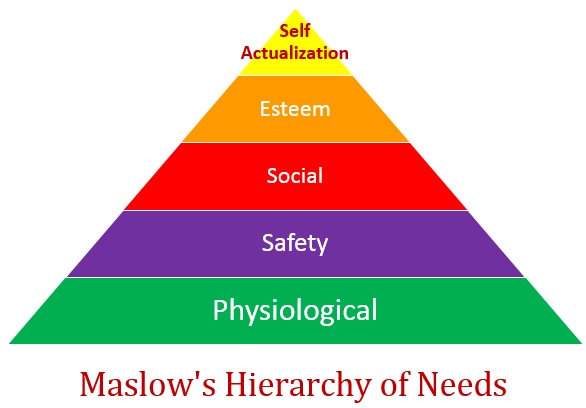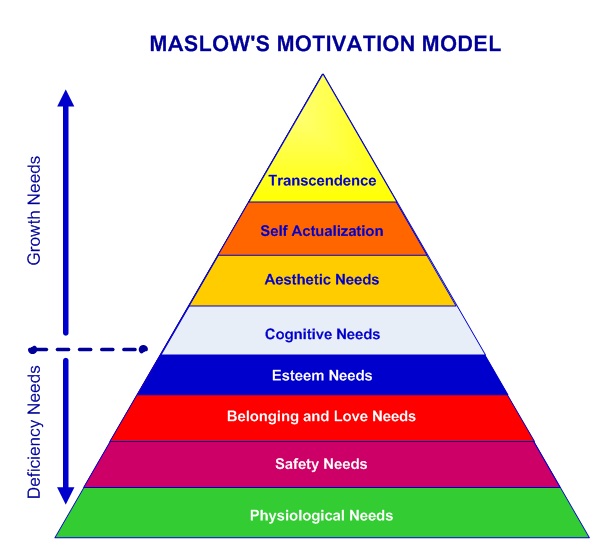Maslow’s Hierarchy of Needs
Psychologist Abraham Maslow introduced the concept of a Hierarchy of Needs. His hierarchy proposes that people are motivated to fulfill basic needs before moving on to meet higher level growth needs.
Maslow’s Hierarchy of Needs is most often displayed as a hierarchical pyramid with five levels. However, the most recent depictions of the hierarchical pyramid have seven or eight levels. But, no matter which pyramid you review, the lowest levels of the pyramid are made up of the most basic needs, while the more complex needs are located at the top of the pyramid. The four lower levels of all the pyramids are considered physiological or deficiency needs, while the top level(s) are considered growth needs. Maslow’s believes that the lower level needs have to be satisfied before higher needs can influence behavior.
Maslow’s Theory of Motivation
The basis of Maslow’s theory of motivation is that human beings are motivated by unsatisfied needs, and that certain lower needs need to be satisfied before higher needs can be addressed.
Needs at the bottom of the pyramid are basic physical requirements including the need for food, air, water, and sleep. Once these lower-level needs have been met, people can move on to the next level of needs, which are for safety and security. Once these needs have been reasonably satisfied, he or she may be able to reach the next level, and eventually after all the lower needs are met, they can reach the highest level called self-actualization.
Maslow’s believed that all people are motivated to move up the hierarchy toward a level of self-actualization. Unfortunately, progress is often disrupted by the in ability to meet lower level needs. He believed a person cannot become self-actualized if he or she is starving for food or if they are still seeking love and affection from others.
The Five Levels in Maslow’s Hierarchy of Needs:
Physiological Needs
Physiological needs deal with the maintenance of the human body. This lowest category includes the most basic needs that are vital to survival, such as the need for water, air, food, and sleep. Maslow believed that these needs are the most instinctive needs because all needs become secondary until these needs are met. If we need water, then little else matters until we have something to drink.
Examples of physiological needs: air, food, water, shelter, warmth, sleep, etc.
Safety and Security Needs
Safety and security needs are about keeping us safe from harm. These needs include shelter, job security, health, and safe environments. If a person does not feel safe in an environment, they will seek to find safety before they attempt to meet any higher level needs. These security needs are important for survival, but they are not as important as the basic physiological needs.
Examples of safety and security needs: safety, shelter, security, law & order, employment, health, stability, etc.
Social Needs
Social needs advance our tribal nature. These are the needs for belonging, love, affection as well as for relationships with family and friends and companionship. These needs are met through pleasing and fulfilling relationships with others. A pleasing and fulfilling relationship would imply acceptance by others. Having satisfied their basic physiological and security needs, people can seek relationships from which their need for love and belonging can be met.
Examples of social needs: Belongingness, love, affection, intimacy, family, friends, relationships, etc.
Esteem Needs
After the more basic needs have been satisfied, esteem needs becomes important to an individual. Once an individual have satisfactorily met their need for love and belonging, they can begin to develop positive feelings of self-worth and self-esteem. Esteem needs are for a higher position within a group and act to foster pride in their work and in themselves as individuals. These needs include self-esteem, respect, achievement, confidence, recognition, and accomplishment.
Examples esteem needs: self-esteem, self-confidence, achievement, recognition, status, respect, etc.
Self-actualizing Needs
Self Actualization is the highest level of Maslow’s hierarchy. This level of need pertains to what a person’s full potential is and realizing that potential. “What a man can be, he must be” is the basis of the perceived need for self-actualization. Maslow describes this as the desire to become everything that one is capable of becoming.
Examples of self-actualizing needs: realizing personal potential, self-fulfillment, pursue talent, personal growth, peak experiences, creativity, etc.
The Eight Stage Maslow’s Hierarchy of Needs
Maslow’s theory has been elaborated upon by other researchers. Maslow’s original five-stage model has been adapted by other researchers who have analyzed Maslow’s theory to develop both seven and eight-stage hierarchy of needs pyramids.
The additional needs are:
Cognitive Needs: Need to know and understand
Aesthetic Needs: need to express oneself in pleasing ways
Transcendence Needs: helping others to achieve self-actualization
Physiological Needs: air, food, water, shelter, warmth, sleep, etc.
Security Needs: safety, shelter, security, law & order, employment, health, stability, etc.
Social Needs: Belongingness, love, affection, intimacy, family, friends, relationships, etc.
Esteem Needs: self-esteem, self-confidence, achievement, recognition, status, respect, etc.
Cognitive needs: knowledge, meaning, understanding, etc.
Aesthetic needs: appreciation and search for beauty, balance, form, etc
Self-actualizing Needs: realizing personal potential, self-fulfillment, pursue talent, personal growth, peak experiences, etc.
Transcendence needs: helping others to achieve self-actualization
Author: James Kelly, May 2014
Other Related Pages:
Principles of learning
Adult-learning
Memory
Learning preferences
Mind-mapping
Chunking
Chunking strategy
References: Maslow’s Hierarchy of Needs
Maslow, A. H. (1943). A Theory of Human Motivation. Psychological Review
Abraham Maslow, Motivation and Personality, 2nd ed., Harper & Row, 1970.




